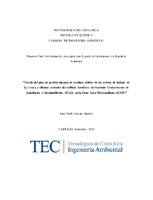| dc.description.abstract | The Costa Rican Institute of Aqueducts and Sewers, currently does not have a Plan of Solid Waste Management duly approved, so, there are many problems in the management of solid waste generated in each work center of the institution. In order to realize this plan design, a characterization and quantification of ordinary RS for 3 months, and a study of findings in two work centers were performed. As study area, two specific sites were chosen: the first made up of Monge, Autofores and Anexos buildings, located in San Jose; and campus "Carlos Segura Z" located in Uruca. In the first study, the residue weighed in greater numbers in both collection stations and cellar used as a temporary storage center during the established period, was the paper with 723, 53 kg. For the second case of study, the residue found in greater amounts in both collection stations and cellar used as a temporary storage center during the established period, was the cardboard with 275, 63 kg. Significant amounts of waste plastic, metal, tetrapack and organic were found, but his percentages were not as representative as compared to paper and cardboard. Large amounts of waste stored in collection stations were found, which is the most critical situation evidenced in the study. At least 8 m2 of area are needed for each temporary collection center, and the space available in each compartment of the temporary collection center, is suitable for storing Solid Waste in a monthly period, before collection. At the end of the study it concluded that the institutional population not apply best practices for the management of RS, and it has much work to do in terms of presentation and use of the collection stations and each temporary collection center. Likewise, it was determined that the implementation of a PGIRS and the incorporation of an enviromental enginner or a manager to the PGAI Commission, would be the key to success for proper management of solid waste from the institution.
Key words: Solid Waste, Characterization and quantification of solid waste, PGIRS Design, Costa Rican Institute of Aqueducts and Sewers. | es |


